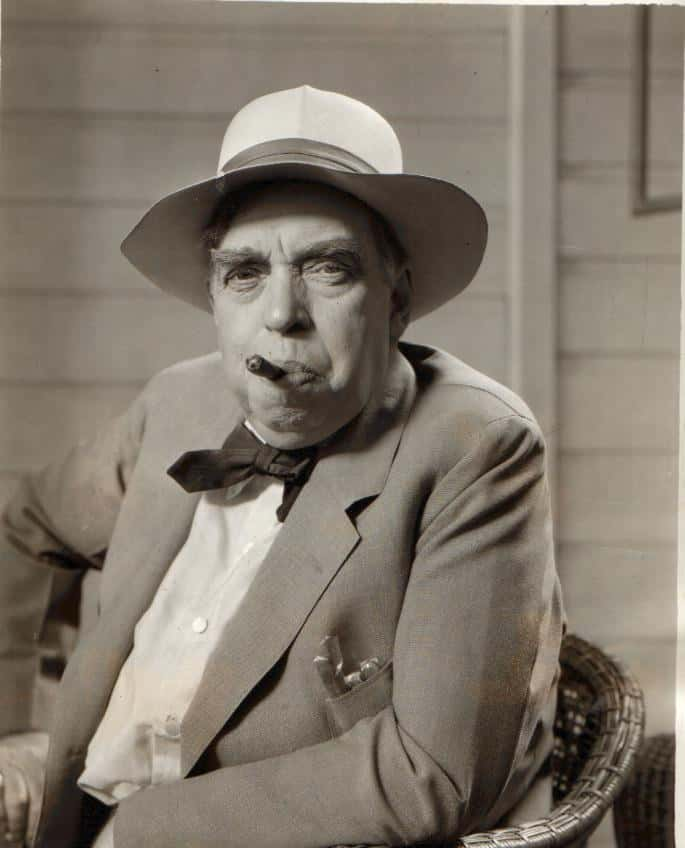Irvin S. Cobb
Written by Justin D. Lamb

(Collection of Paducah Market House Museum)
With a round shape, bushy eyebrows, full lips, and triple chin to go along with his immense personality, Irvin S. Cobb certainly left an impression on his native western Kentucky. Cobb was one of the biggest celebrities in early 20th Century America, authoring over 60 books and writing and starring in several motion pictures. Sadly, though, as years have passed, the life and works of Irvin Cobb have been largely forgotten by his fellow western Kentuckians.
The second of four children of Joshua and Manie Saunders Cobb, Irvin Shrewsbury Cobb was born in Paducah, Kentucky on June 23, 1876 in the home of his grandfather, Dr. Rueben M. Saunders, who gained notoriety for discovering the cure for cholera in 1873. Cobb was raised in Paducah where he attended the local common schools, but it was the colorful people and events around him that truly educated him and later influenced his writings.
At the age of 16, Cobb’s grandfather passed away and his father became an alcoholic. These series of events forced Cobb to quit school to care for his mother and siblings. Cobb took up writing to care for his family; a decision that set him on a path that forever changed his life.
Cobb was soon hired as a journalist for the Paducah Daily News, and at age 19, he became the nation’s youngest news editor. His work soon caught the attention of the Louisville Evening Post where he was hired in 1898. One of his anecdotal pieces, “Exit Laughing,” which covered the assassination of Kentucky Governor William Goebel and the aftermath that ensued, gained critical claim, but by 1901, Cobb was forced to return to Paducah where he began writing for the Paducah Democrat. Restless and unhappy, Cobb decided, much to the encouragement of his wife, Laura, to try his luck in New York City. Cobb took a leap a faith and moved to the Big Apple in 1903.
After several rejections and a few slammed doors to the face, Cobb was eventually hired by the New York Evening Sun and his first assignment was coverage of the Russia-Japanese peace conference in Portsmouth, New Hampshire. Cobb’s focus on personalities at the peace conference in his writings, especially that of President Theodore Roosvelt who served as mediator at the conference, caught the attention of Joseph Pulitzer who hired Cobb at New York World in late 1905. Cobb became the highest paid staff reporter in the United States at the time and he was also hired to cover the events of World War I for the Saturday Evening Post.
Arguably, Cobb’s best work was his humorous stories and anecdotes of Kentucky local color he remembered from his boyhood. Cobb’s most famous work, Old Judge Priest (1915), was based on Judge William Sutton Bishop of Paducah. Judge Bishop served as County Judge of McCracken County during Cobb’s childhood and later as Circuit Judge for Marshall and McCracken Counties from 1892 to 1898.
From Judge William Sutton Bishop’s lackadaisical appearance, vast knowledge of the law, gentle manner, and his absentmindedness, Cobb created Judge William Pittman Priest, the focal character of Old Judge Priest. Joel Harris, a journalist and contemporary of Cobb’s, wrote of these tales, “Cobb created a South peopled with honorable citizens and charming eccentrics….but at their best the Judge Priest stories are dramatic and compelling, using a wealth of precisely rendered detail to evoke a powerful mood.”
Cobb’s writings became immensely popular throughout the United States and several of his stories became adapted into motion pictures including The Woman Accused (1933) starring Cary Grant, and his Old Judge Priest character was transcended onto the big screen in Judge Priest (1934) starring Will Rogers and The Sun Shines Bright (1953) starring Charles Winninger. Cobb also took part in acting and he appeared in 10 films between 1932 and 1938 and he had starring roles in Hawaii Calls (1938) and Everybody’s Old Man (1936). Cobb was also host of the 7th Academy Awards in 1935 which took place at the Biltmore Hotel in Los Angles.

Irvin Cobb presents Shirley Temple with the Academy Juvenile Award at the 7th Academy Awards in 1935.
(Courtesy of Paducah Market House Museum)
After a very successful career that spanned over two decades, Cobb’s star began to fade just as quickly as it rose by the early 1940s as his homespun style of writing was seen as outdated. In a vastly changing world, his demeaning, subservient portrayal of black Americans in his stories fell out of favor with the New York editors and Hollywood screenwriters, and in 1941, Cobb’s national syndicated column which had run continuously since 1922 was canceled.
After a series of health problems, Cobb passed away on March 11, 1944 in New York City. He was cremated and his ashes were shipped home to Paducah and placed under a Dogwood tree in Oak Grove Cemetery with a large granite boulder marking his final resting spot.
Anita Lawson commented in her 1984 biography Irvin S. Cobb, “The story of Irvin S. Cobb is a fascinating one for many reasons. His life was not unusual at the time: a Horatio Alger rise from poor boy to world authority through hard work. Associate of celebrities of all kinds for two decades, he died in Hollywood virtually forgotten, having outlived the world he grew up in and which appreciated him.”
